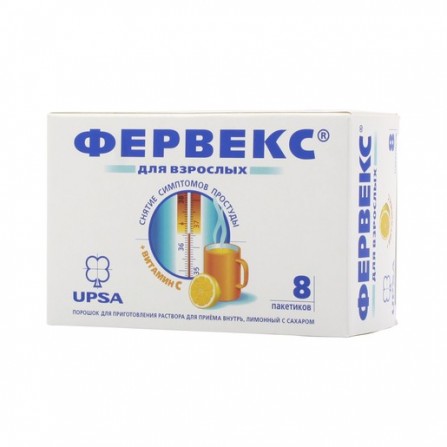Fervex powder for preparation of solution lemon with sugar of 13.1 g 8 pieces
Condition: New product
1000 Items
Rating:
Be the first to write a review!

More info
Active ingredients
Paracetamol + Pheniramine + Ascorbic Acid
Release form
Powder
Composition
Paracetamol (Paracetamolum) 500 mg; Pheniraminum (Pheniraminum) 25 mg; Ascorbic acid (Acidum ascorbinicum) 200 mg. Excipients: sucrose; anhydrous citric acid; gum arabic; soluble saccharin; lemon-rum flavor (antilles)
Pharmacological effect
Paracetamol has an analgesic and antipyretic effect, which is associated with its effect on the thermoregulation center in the hypothalamus; eliminates headache and other types of pain, reduces fever.; Ascorbic acid (vitamin C) is involved in the regulation of redox processes, carbohydrate metabolism, blood clotting, tissue regeneration, the synthesis of corticosteroids, collagen and procollagen; normalizes capillary permeability. Increases the body's resistance, which is associated with the stimulation of the immune system.; Pheniramine, a blocker of the H1-histamine receptors, reduces rhinorrhea, nasal congestion, sneezing, tearing, itching and redness of the eyes.
Pharmacokinetics
Paracetamol is rapidly and almost completely absorbed from the gastrointestinal tract. Cmax in plasma is reached in 10-60 minutes after ingestion. Distributed in most body tissues. Gets through a placental barrier, it is allocated with breast milk. At therapeutic concentrations, plasma protein binding is low, but increases with increasing concentration. Subject to primary metabolism in the liver. Excreted mainly in the urine in the form of glucuronides and sulfates. T1 / 2 ranges from 1 to 3 hours; Pheniramine; Cmax of phenyramine in plasma is reached in approximately 1-2.5 hours. T1 / 2 of phenyramine - 16-19 hours. 70-83% of the dose is eliminated from the body through urine as metabolites or unchanged. Ascorbic acid. Well absorbed in the digestive tract. Tmax after ingestion - 4 hours. Metabolized mainly in the liver. Excreted by the kidneys, through the intestines, with sweat - unchanged and in the form of metabolites.
Indications
Infectious and inflammatory diseases (ARVI, influenza), accompanied by high fever, chills and fever, headache, runny nose, nasal congestion, sneezing and muscle pain.
Contraindications
Hypersensitivity to paracetamol, ascorbic acid,Pheniramine or any other component of the drug; erosive and ulcerative lesions of the gastrointestinal tract (in the acute phase); renal failure; portal hypertension; alcoholism; deficiency of the enzyme glucose-6-phosphate dehydrogenase; children's age (up to 15 years); pregnancy (I and III trimester) and lactation.
Use during pregnancy and lactation
Contraindicated
Dosage and administration
Inside, completely dissolved in a glass (200 ml) of warm water (50–60 ° C), immediately drink the resulting solution. It is better to take the drug between meals.; 1 sachet 2-3 times a day. The interval between doses of the drug should be at least 4 hours. In patients with impaired liver or kidney function and in elderly patients, the interval between doses of the drug should be at least 8 hours; The duration of the reception without consulting a doctor is no more than 5 days when prescribed as an anesthetic. means and not more than 3 days - as a febrifuge.
Side effects
The drugs are well tolerated in the recommended doses.; Nausea, pain in the epigastric region, allergic reactions (skin rash, pruritus, urticaria, angioedema); Rarely - hematopoietic disorders (anemia, thrombocytopenia, methemoglobinemia), dry mouth, paresis of accommodation, leaking, metashemoglobinemia, dry mouth, paresis of accommodation, leaking, metashemoglobinemia, dry mouth, paresis of accommodation, leaking, metashemoglobinemia, dry mouth, paresis of accommodation, leaking, metashemoglobinemia, dry mouth, paresis of accommodation, leaking, metashemoglobinemia, dry mouth, paresis of accommodation, leeching urine drowsiness. With prolonged use (in doses significantly higher than recommended) increases the likelihood of impaired liver and kidney function, control of the peripheral blood picture is necessary. All side effects of the drug should be reported to the doctor. If adverse reactions occur, stop taking the drug and consult a doctor.
Overdose
Symptoms of an overdose due to paracetamol: pallor of the skin, loss of appetite, nausea, vomiting; hepatonecrosis (severity of necrosis due to intoxication depends on the degree of overdose). Toxic effects in adults are possible after taking more than 10–15 g of paracetamol: increased activity of hepatic transaminases, an increase in PV (12–48 hours after ingestion); A detailed clinical picture of liver damage occurs after 1–6 days. Rarely, liver failure develops at lightning speed and may be complicated by renal failure (tubular necrosis); Treatment: during the first 6 hours after an overdose, gastric lavage, administration of SH-groups and precursors of glutathione-methionine synthesis 8–9 hours after overdose and N-acetylcysteine through 12 h.The need for additional therapeutic measures (the further introduction of methionine, in / in the introduction of N-acetylcysteine) is determined by the concentration of paracetamol in the blood, as well as the time that has passed since taking it.
Interaction with other drugs
Ethanol enhances the sedative effect of antihistamines.; Antidepressants, anti-Parkinsonian drugs, antipsychotics (phenothiazine derivatives) increase the risk of side effects (urinary retention, dry mouth, constipation). GCS increases the risk of glaucoma.; Inductors of microsomal oxidation in the liver (phenytoin, ethanol, barbiturates, rifampicin, phenylbutazone, tricyclic antidepressants) increase the production of hydroxylated active metabolites, which makes it possible for severe intoxication to develop with small overdose. Ethanol contributes to the development of acute pancreatitis. Inhibitors of microsomal oxidation (including cimetidine) reduce the risk of hepatotoxic action. Paracetamol reduces the effectiveness of uricosuric drugs.
special instructions
Perhaps the distortion of indicators of laboratory tests in the quantitative determination of the concentration of uric acid and glucose in plasma. In order to avoid toxic damage to the liver, paracetamol should not be combined with the intake of alcoholic beverages, as well as be taken by persons prone to chronic alcohol consumption. The risk of liver damage increases in patients with alcoholic hepatosis. In the case of taking the drug, patients suffering from diabetes or on a diet with a low sugar content, it should be noted that each bag contains 11.5 g of sugar, which corresponds to 0.9 XU .




